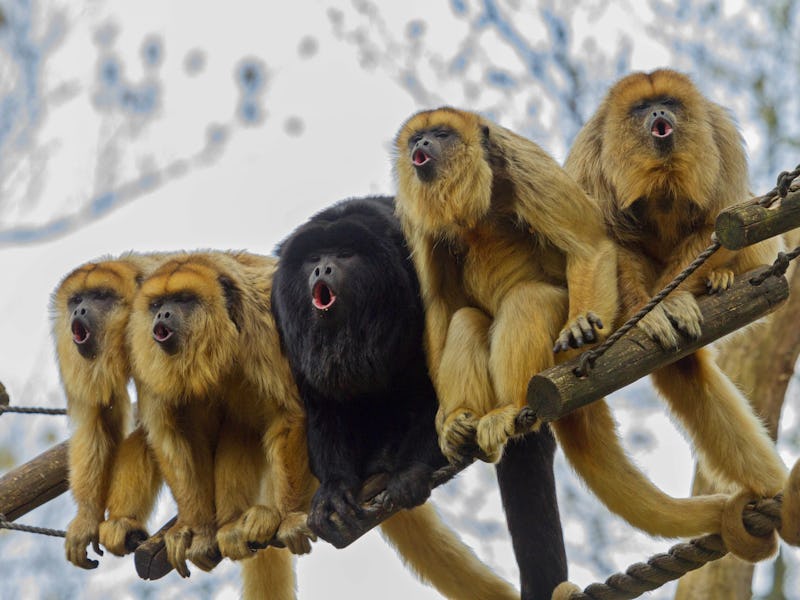Discovery of new monkey lineage points to an incredible, transatlantic journey
Researchers have discovered a totally unknown primate lineage that rafted across the ocean to South America

Peru's Amazon is like a bustling city, alive with the calls, sights, and movements of dozens of monkeys, including howler monkeys, spider monkeys, and golden-mantled tamarins.
But these monkeys haven't always called the region their home. Researchers believe this now-thriving primate populace all started with a group of monkeys that made an incredible journey out of Africa, some 30 million years ago.
Turns out they were wrong. There were two groups of primate pioneers which made the intrepid voyage.
New fossil discoveries reveal that South America's monkeys owe their existence to two distinct groups of ancient primates. One of these prehistoric lineages has never been discovered outside of Africa before.
The revelation stems from four fossils of primate molar teeth which suggest two primate lineages rafted across the Atlantic Ocean from Africa to South America, tens of millions of years ago.
Bizarre as it sounds, researchers already knew that one type of monkey had set sail from Africa to the New World. These ancient mariners likely made their voyage during the Oligocene epoch, some 33.9 million to 23 million years ago.
Researchers thought these monkeys were the sole ancestors of modern American monkeys, but the discovery tells a different story.
"It was a total surprise to find these new fossils of a different group,” says lead study author Erik Seiffert, a professor at the University of Southern California.
Tiny molar teeth of the parapithecid monkey Ucayalipithecus from the Oligocene of Perú
Known as parapithecids, these monkey fossils have previously been discovered in Africa, but never in South America, Seiffert tells Inverse.
But somehow, parapithecids must have made the transatlantic journey to the Amazon. There, they led to the newly discovered lineage of primates, which the researchers have dubbed Ucayalipithecus perdita.
Seiffert explains how they likely made the leap:
“The ancestors of Ucayalipithecus found themselves on a large raft of vegetation that had broken away from the coastline," he says. That make-shift raft then would have "slowly drifted to the west," before beaching on the New World.
Subject to the whims of the Atlantic ocean currents, the arduous journey may have taken as long as two weeks, he says. Yet, the monkeys made it alive, and able to thrive.
Their size may be what enabled their survival against the odds. Parapithecids were tiny, weighing in at about 350 grams. That's less than a 1 pound bag of sugar. Their tiny size means they didn't need much food or water to survive the trip.
Life in the New World — The discovery of Ucayalipithecus also marks the third mammal lineage to make its presence felt in the New World. Aside from the monkeys, a group of rodents, called caviomorphs, also took root in the Western Hemisphere. The first of their kind in South America, these ancient rodents have led to modern animals like chinchillas, New World porcupines, and capybaras.
We have some clues as to what life was like in those strange ancient times.
Tiny monkeys rafted across the Atlantic Ocean to start a life in the New World.
What we know about the tiny Ucayalipithecus’ behavior comes from their “better-known relatives from Africa,” Seiffert says. Fossils of those species, Apidium and Parapithecus, have been found in 30 to 32-year-old deposits in Egypt. They include crania, jaws, and other bones.
As a result, we know that parapithecids lived in trees, and were probably agile leapers, Seiffert says. The newly discovered molars also hold insights that color in a few more details about their world: The teeth suggest the monkeys primarily ate fruit, as well as some gums and insects.
Parapithecids likely lived in groups, and displayed some sexual dimorphism, Seiffert says. Males had larger fangs than females, for example.
The monkeys who made it across the ocean had to survive some tough conditions. They must have been able to adapt quickly to their new territory. They probably fed on hard fruits and seeds, and over time, they diversified, creating the many curious (often loud) primates which inhabit South America's forests today.
Today, more than 30 monkey species live in Peruvian Amazonia. It is one of the most biodiverse places on Earth.
Now, we know a bit more about these monkeys' humbling history, and the intrepid journeys that may have given these incredible creatures their start.
Abstract: Phylogenetic evidence suggests that platyrrhine (or New World) monkeys and caviomorph rodents of the Western Hemisphere derive from source groups from the Eocene of Afro-Arabia, a landmass that was ~1500 to 2000 kilometers east of South America during the late Paleogene. Here, we report evidence for a third mammalian lineage of African origin in the Paleogene of South America—a newly discovered genus and species of parapithecid anthropoid primate from Santa Rosa in Amazonian Perú. Bayesian clock–based phylogenetic analysis nests this genus (Ucayalipithecus) deep within the otherwise Afro-Arabian clade Parapithecoidea and indicates that transatlantic rafting of the lineage leading to Ucayalipithecus likely took place between ~35 and ~32 million years ago, a dispersal window that includes the major worldwide drop in sea level that occurred near the Eocene-Oligocene boundary.